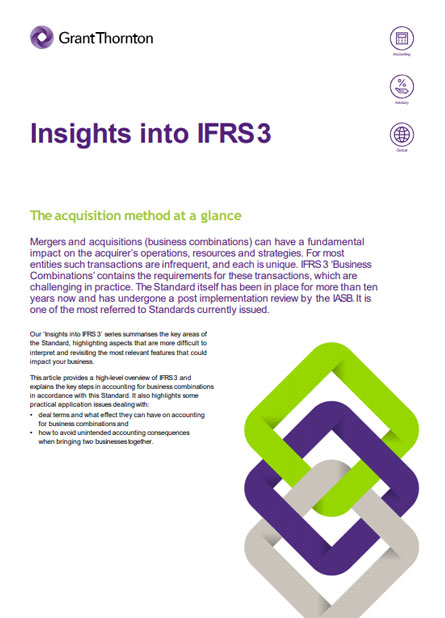-
Business Risk Service
Organisations must understand and manage risk and seek an appropriate balance between risk and opportunities.
-
Transaction Advisory, M& A, Business Consultancy
Transaction Advisory, M& A, Business Consultancy
-
IT Advisory
IT Advisory
-
Business Process Solutions
Business Process Solutions
-
Managing the VAT Audit
Managing the VAT Audit
-
Transfer Pricing
Global transfer pricing is all about understanding your business and the value drivers of your industry in an ever-changing environment.
Mergers and acquisitions (business combinations) can have a fundamental impact on the acquirer’s operations, resources, and strategies. IFRS 3 ‘Business Combinations’ is one of the most referred to Standards currently issued and contains the requirements for these transactions, which are challenging in practice.
This article provides a high-level overview of IFRS 3 and explains the key steps in accounting for business combinations in accordance with this Standard. It also highlights some practical application issues dealing with:
- deal terms and what effect they can have on accounting for business combinations
- how to avoid unintended accounting consequences when bringing two businesses together.
The acquisition method
IFRS 3 establishes the accounting and reporting requirements (known as ‘the acquisition method’) for the acquirer in a business combination. The key steps in applying the acquisition method are summarised below:
Step 1 - Identifying a business combination
Most traditional acquisitions, such as the purchase of a controlling interest in an unrelated operating entity, are business combinations within the scope of IFRS 3. However, many transactions or other events involving the purchase of another entity or groups of assets require further analysis to determine
whether:
- what was acquired constitutes a business
- control, as defined by IFRS 10, has been obtained
- the combination is within the scope of IFRS 3.
Step 2 - Identifying the acquirer
The party identified as the accounting acquirer will most often be the legal owner (the accounting acquirer is usually the entity that transfers the consideration ie cash or other assets). However, IFRS 3 requires an in-substance approach to identify the party that obtained control (ie the acquirer). This approach looks beyond the legal form of the transaction and considers the rights of the combining entities and their former owners.
Step 3 - Determining the acquisition date
The acquisition date is the date the acquirer obtains control of the acquiree, usually the specified closing or completion date of the business combination.
Step 4 - Recognising and measuring identifiable assets acquired and liabilities assumed
This is typically the most complex and time-consuming step which requires the acquirer to:
- recognise identifiable assets acquired and liabilities assumed at the acquisition date, including some intangible assets that may not have been previously recognised in the acquiree’s financial statements
- measure identifiable assets acquired and liabilities assumed at fair value, with a few exceptions
- determine the applicability of some specific recognition and measurement provisions
- classify or designate the assets acquired and liabilities assumed.
Step 5 - Recognising and measuring any non-controlling interest (NCI)
The acquirer has a choice to measure present ownership-type NCI at either fair value or the proportionate interest in the acquiree’s recognised identifiable net assets. When making the choice, a number of factors should be considered. Decisions made at the time of the business combination cannot be revisited. The measurement of NCI affects the amount of goodwill that can be recognised and it can also impact post-combination reported results.
Step 6 - Determining the consideration transferred
Consideration transferred can include cash and other assets transferred, liabilities incurred and equity interests issued by the acquirer. Some consideration may be deferred or be contingent on future events.
In addition, consideration transferred in exchange for the acquired business may be different from the contractual purchase price if the overall transaction includes elements that are not part of the business combination exchange. For example, the following must be accounted for separately from the business combination:
- acquisition-related costs, including:
- reimbursement of those incurred by the acquiree or the former owners
- those paid directly to third parties
- the effective settlement of a pre-existing relationship between the acquirer and acquiree.
Contracts to acquire shares from non-selling shareholders at a later date
These contracts may be negotiated at or around the same time as the business combination.
Financial reporting effects
- a contract that in substance represents the purchase, at the date of acquisition, of the remaining acquiree shares is accounted for as part of the business combination, as a deferred or contingent consideration arrangement. As the remaining shares held by NCI are considered to
have been acquired at the date of acquisition, the acquirer is considered having already acquired 100% of the acquiree shares and as such, no NCI should be recognised - contracts that are in substance arrangements to purchase NCI shares at a future date after the acquiring entity gains control of the subsidiary (also referred to as put options over NCI) should be accounted for as a separate transaction. It should not be considered part of the business
combination.
Reporting business combinations and avoiding surprises
Reporting a business combination is a significant exercise. A considerable amount of time and effort usually needs to be put into gathering, assembling and evaluating all the information required to be reported in the financial statements under IFRS 3. Presented below are some planning considerations
and suggestions on how they can be implemented.
During the deal negotiation
- understand the accounting effects of the terms set out in the sale and purchase agreement
- identify related transactions or other elements that may require separate accounting
- identify transactions/agreements or other arrangements that have negotiated at or near the same time to assess whether they should form part of the business combination.
Implementation hints
Involve finance/accounting personnel in the early stages of the negotiation to assist in evaluating the accounting effects of the deal terms. Applying the acquisition method
Identifying intangible assets
- these assets are more challenging to identify as they are often not recognised in the acquiree’s financial statements.
Identifying contingent liabilities
- the acquirer should recognise at the acquisition date a contingent liability assumed in a business combination if it is a present obligation and its fair value can be measured reliably.
Implementation hints
Consider various sources of information that may provide valuable inputs in detecting contingent liabilities:
- legal correspondence
- results of due diligence
- documentation and communication with suppliers.
Valuation process
- fair values of certain items may not be readily available and may require complex estimates.
Implementation hints
- implement a robust process in developing fair value estimates
- assistance from valuation experts may be required if the acquirer does not have the relevant expertise and experience in valuation.
Determining consideration transferred
- need to consider the effects of transactions that are not part of the business combination under IFRS 3
Implementation hints
Consider the commercial reasons for each material element of the transaction, who initiated it and its timing.
Making an accounting policy choice
- accounting policy choices can be made in certain areas, for example:
- measurement of NCI
- classification and designation of assets acquired and liabilities assumed.
Implementation hints
Assess the implications of the choices available, including the immediate effect on the acquisition date; the relative ease of applying a particular choice; the subsequent accounting requirements; and the related impact on post-combination earnings.
Determining the need for outside experts
- some entities enter into frequent business combination transactions but for others, these are one-time events. The entity may then not have the adequate resources to apply IFRS 3’s requirements.
Implementation hints
- assess the skills and relevant experience of the finance team to determine whether external consultants are required to assist with the purchase price allocation process that is set out in IFRS 3
- this decision should be made early in the process to ensure the quality of financial information and avoid unnecessary delays.
Timely completion of the accounting for the business combination
- the accounting for a business combination, including all the required disclosures, should be completed within the measurement period (which should not exceed 12 months after the acquisition date). Depending on the complexity of the business combination, this time frame may be challenging.
Implementation hints
- plan early
- identify all the relevant requirements, gather required information and assess the needed resources
- engage external consultants as necessary and agree on scope of work, due dates and deliverables
- implement a project plan and monitor progress of activities regularly
- engage your auditor early!
How we can help
We hope you find the information in this article helpful in giving you some insight into IFRS 3. If you would like to discuss any of the points raised, download our publication and speak to our Grant Thornton Bahrain contacts.

